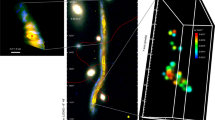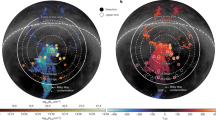Abstract
IN a study of the CO distribution in the Galaxy, Bash and Peters1 concluded that there is an upper limit of 30 Myr to the age of stellar systems which contain CO. Younger systems, launched by the impulse of the density wave show abundant CO emission. Systems which have existed for longer than 30 Myr display no CO emission. Based on their initial observations, Bash and Peters predicted that there would be a correlation between the presence of CO emission and the turnoff in open clusters. Observations by Green confirm this prediction2 showing CO emission in at least 24 of 28 clusters with turnoff earlier than spectral type BO and no evidence of CO emission in 35 of 38 clusters with turnoff later than BO. We suggest that there is a critical mass Mcrit such that for M > Mcrit stars do not evolve to an explosive phase and hence the surrounding molecular cloud is substantially unaffected by the evolving stars. As the system ages, the most massive star with M < Mcrit finally evolves to an explosive endpoint and the resulting supernova dissipates the dense molecular cloud. From the cluster observations we identify Mcrit ∼ 15–20M⊙, the mass of a BO star (ref. 3 and E. Green, private communication), although there is some uncertainty in luminosity class.
This is a preview of subscription content, access via your institution
Access options
Subscribe to this journal
Receive 51 print issues and online access
$199.00 per year
only $3.90 per issue
Buy this article
- Purchase on Springer Link
- Instant access to full article PDF
Prices may be subject to local taxes which are calculated during checkout
Similar content being viewed by others
References
Bash, F. N. & Peters, W. L. Astrophys. J. 205, 786 (1976).
Bash, F. N., Green, E. M. & Peters, W. L. Astrophys. J. in press (1977).
Ostriker, J. P., Richstone, D. O. & Thuan, T. X. Astrophys. J. Lett. 188, L87 (1974).
Mouschovias, T. Ch., Astrophys. J. 207, 141 (1976).
Spitzer, L. Jr, Diffuse Matter in Space (Interscience, New York, 1968).
Kwan, J. & Scoville, N. Astrophys. J. Lett. 210, L39 (1976).
Wheeler, J. C. & Shields, G. A. Nature 259, 642 (1976).
Author information
Authors and Affiliations
Rights and permissions
About this article
Cite this article
WHEELER, J., BASH, F. Supernovae and molecular clouds. Nature 268, 706–707 (1977). https://doi.org/10.1038/268706a0
Received:
Accepted:
Issue Date:
DOI: https://doi.org/10.1038/268706a0
This article is cited by
-
Local interstellar medium
Astrophysics and Space Science (1987)
Comments
By submitting a comment you agree to abide by our Terms and Community Guidelines. If you find something abusive or that does not comply with our terms or guidelines please flag it as inappropriate.



